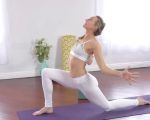- 1- Introduction to Yoga for Stress Relief
- 2- How Yoga Helps with Stress Relief
- 3- Best Yoga Poses for Stress Relief
- 4- The Importance of Breathing Techniques in Yoga
- 5- Combining Yoga and Mindfulness for Stress Reduction
- 6- How to Start Practicing Yoga for Stress Relief
- 7- Conclusion: Incorporating Yoga into Your Routine for Long-Term Benefits
1- Introduction to Yoga for Stress Relief
In today's fast-paced world, stress has become a common part of daily life, affecting both our mental and physical well-being. With the increasing demands of work, personal responsibilities, and technology, it can be difficult to find ways to relax and rejuvenate. One of the most effective methods for managing stress is through yoga. But how can you practice yoga for stress relief? This article explores the benefits of yoga, its specific poses, breathing techniques, and how to incorporate it into your daily routine to alleviate stress.
2- How Yoga Helps with Stress Relief
Yoga has long been known for its ability to promote relaxation, reduce anxiety, and enhance overall well-being. The combination of physical movement, mindful breathing, and meditation helps to activate the parasympathetic nervous system, which is responsible for the body's relaxation response. When practiced regularly, yoga helps to lower cortisol (the stress hormone) levels, improve sleep quality, and increase mental clarity. Unlike other forms of exercise, yoga encourages mindfulness, which is the practice of being fully present in the moment, free from judgment. This mindful approach allows you to disconnect from daily stressors, creating a space for healing and emotional balance.
3- Best Yoga Poses for Stress Relief
Yoga poses are designed to open the body, relax the muscles, and restore balance. Certain poses are especially beneficial for stress relief, including:
- Child's Pose (Balasana): This restorative pose promotes deep relaxation and is ideal for calming the mind and relieving tension in the back, neck, and shoulders.
- Downward-Facing Dog (Adho Mukha Svanasana): A great way to stretch the entire body, especially the hamstrings, back, and arms, while calming the nervous system.
- Cat-Cow Pose (Marjaryasana-Bitilasana): This sequence is effective for loosening up the spine and relieving tension in the neck and back, helping to release emotional tension stored in the body.
- Legs-Up-The-Wall Pose (Viparita Karani): This pose is incredibly calming and helps reduce anxiety by encouraging blood flow to the head and allowing the body to relax.
- Seated Forward Fold (Paschimottanasana): This gentle stretch targets the hamstrings and lower back while promoting deep relaxation and reducing stress.
4- The Importance of Breathing Techniques in Yoga
One of the most effective tools in yoga for stress relief is conscious breathing. By focusing on your breath, you can immediately activate the relaxation response in your body. Here are a few key breathing techniques that can help reduce stress:
- Pranayama: This ancient technique involves controlled breathing to increase energy, calm the mind, and restore balance. One common practice is Ujjayi breath, which involves gently constricting the back of the throat while breathing, creating a soothing sound and calming effect.
- Box Breathing: Also known as square breathing, this technique involves inhaling for a count of four, holding the breath for four, exhaling for four, and holding again for four. It helps to regulate the nervous system and promote a sense of calm.
- Alternate Nostril Breathing (Nadi Shodhana): This technique helps balance the left and right sides of the brain, calming the nervous system and promoting relaxation.
5- Combining Yoga and Mindfulness for Stress Reduction
Yoga is not just about physical postures; it’s a practice of mindfulness that focuses on bringing awareness to the present moment. Mindfulness helps to reduce stress by quieting the mind and allowing individuals to observe their thoughts without becoming overwhelmed by them. By incorporating mindfulness into your yoga practice, you can become more aware of how stress manifests in your body and mind, allowing you to release it more effectively. A mindful approach to yoga emphasizes conscious movement, awareness of breath, and acceptance of whatever arises during the practice. This combination of body and mind creates a powerful tool for managing stress.
6- How to Start Practicing Yoga for Stress Relief
Getting started with yoga for stress relief doesn’t require extensive experience or special equipment. Here are some simple steps to begin:
- Find a Comfortable Space: Set up a quiet space where you can practice yoga without distractions. A calm environment enhances your ability to relax and focus on the practice.
- Start with Basic Poses: If you’re new to yoga, start with basic poses like Child's Pose, Downward-Facing Dog, and Seated Forward Fold. These poses are gentle and easy to incorporate into your daily routine.
- Practice Breathing Techniques: Set aside time each day to practice deep breathing techniques, such as Box Breathing or Ujjayi breath, to calm the nervous system and alleviate stress.
- Be Consistent: For the best results, aim to practice yoga at least 2-3 times a week. Consistency helps train your body and mind to respond to stress in a healthier way.
7- Conclusion: Incorporating Yoga into Your Routine for Long-Term Benefits
Yoga is an incredibly effective way to relieve stress, restore balance, and improve overall well-being. By incorporating yoga poses, mindful breathing techniques, and meditation into your routine, you can manage stress more effectively and enhance your mental and physical health. Whether you’re new to yoga or have been practicing for years, the benefits of using yoga for stress relief are undeniable. Take the first step towards reducing stress and improving your health by practicing yoga today. If you're looking for expert resources, guides, or classes, feel free to check out Free Yoga Links for the best recommendations tailored to your needs.








